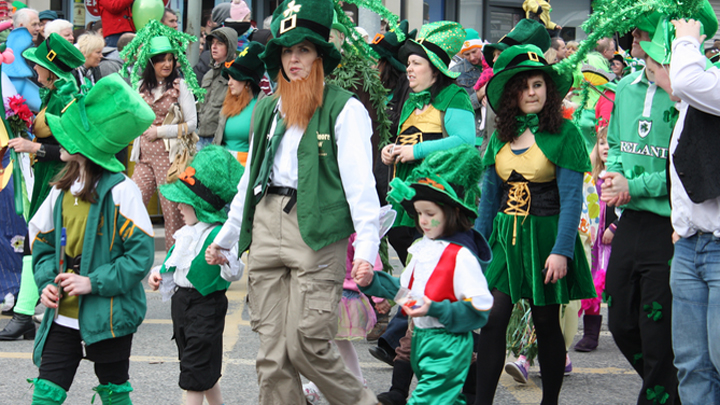Celebrating St Patrick’s Day

Once again it’s Saint Patrick’s Day. The day when all good Irish people forget that they are in the middle of Lent and proceed to enjoy themselves famously. Usually with the assistance of various helpful liquids! Many pubs dye their beer green for the day, which would be a bit off-putting for most people, but for the Irish it’s a required part of the celebrations. As is the availability of Guinness, by far Ireland’s most famous export, it’s rich, black body and pale brown head lubricating several million throats all over the world, and not just on Saint Pat’s Day either! Nor do you have to be Irish to enjoy the stuff, which is one of the main reasons for the enormous quantities exported all over the world, or even brewed there these days, with Guinness breweries now situated in England and Australia. (Aficionados of Guinness swear that the only true drink is the one actually made in Ireland, with the others just being inferior copies – but I’m not an expert so I can’t say if this is true or not!)

Saint Patrick’s Day has been celebrated in Ireland since as early as the ninth century where it has always been an official ‘Holy Day of Obligation’, the meaning of which escapes me. It became a public holiday as recently as 1903, thanks to the Bank Holiday Ireland Act introduced by James O’Mara, who later also introduced another law requiring pubs to close on the day, because drinking was getting out of hand! That little gem wasn’t repealed until the 1970s!
Little is known about Patrick himself, though we know he was born (ironically) in Roman Britain, not Ireland, in the fourth century. At the age of 16, he arrived in Ireland, not as a saint, but as a slave, where he was kept as far as we know, somewhere in Mayo. It was while he was there that he was told by God, in a dream, to flee to the coast, where he gained passage on a ship going to England, and from there he travelled to France, where he studied to be a priest.

In 432 he went back to Ireland, as a Bishop and Christianised the country for thirty years, before dying and being buried at Downpatrick, so he obviously didn’t let his period of slavery get him down!
We all associate the colour green with Saint Patrick, hence that special brew of beer, the shamrock leaf and the clothes worn by leprechauns, but originally the colour associated with him was blue. Why the first colour was used and why it eventually changed to green I have no idea, but certainly no other colour can be used on his day now. It is believed that he used the three-leaved shamrock to help explain the holy trinity, so perhaps it was the use of that plant that caused the colour to eventually change from blue to green. The phrase ‘the wearing of the green’ refers to the habit of wearing a shamrock leaf on one’s clothing, and during the great rebellion of 1798, even the Irish soldiers involved, wore uniforms which were green in colour on their 17th of March Saint Patrick’s Day parade to make a political statement and to draw attention to the cause.
Even today, Saint Patrick’s Day is one of the most popular Saints’ days in the world of Catholicism, I would guess as much as anything, because of the great numbers of Irish men and women who have bravely populated most countries on earth, especially since the great potato famine between 1842 and 1845. These people made good lives wherever they went and yet they still maintained many of the old traditions, especially the religious ones, from back home, with the Saint’s day being important among them. We all tend to make good-humoured jokes about the Irish, don’t we, but it took great courage and intelligence for so many of them to make a success worldwide, as they did!
How do you celebrate St Paddy’s Day? Tell us in the comments below…








 Proudly Australian owned and operated
Proudly Australian owned and operated